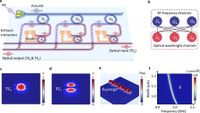The interaction between light and sound is central to the advancements in hybrid technology, particularly in integrated circuits that combine the properties of photonics and phononics. Recently, researchers have overcome significant challenges in developing scalable photonic-phononic integrated circuits using gallium nitride (GaN) on sapphire. This innovative approach delivers enhanced interaction strength and supports complex signal processing, which is crucial for next-generation communications.
The research, published on March 19, 2025, details how both optical and acoustic fields can be confined within sub-wavelength scales without the need for suspended structures. This breakthrough enables efficient launching, flexible routing, and reconfigurable processing of signals, establishing a platform that promises to revolutionize photonic-phononic systems.
The authors of the article emphasized that "This work provides an ideal platform for achieving ultimate performance of photonic-phononic hybrid systems with high efficiency, multiple functions, and large scalability." By integrating photonic and phononic components on a single chip, the researchers have laid the groundwork for sophisticated systems capable of performing diverse functions.
Historically, hybrid systems have significantly surpassed the capabilities of their individual domains. For instance, while hybrid electronic-photonic systems have already made their mark in communication technologies, photonic-phononic integrations were still in the early stages due to limited material choices and design complications. The simultaneous confinement of optical and acoustic fields is essential for developing practical applications in these hybrid systems. However, traditional materials often failed to satisfy the necessary confinement conditions, primarily requiring the use of complex, suspended architectures that compromised device efficiency and reliability.
The new GaN-based platform solves this critical issue. GaN exhibits a higher optical refractive index compared to sapphire, along with lower acoustic velocities, allowing for the simultaneous confinement of both field types within the waveguide. This feat is achieved without resorting to suspended structures, which significantly enhances layout flexibility and device robustness.
In their experimental setup, the researchers fabricated a large-scale photonic-phononic integrated circuit equipped with functionality for signal launching, routing, combining, and de/multiplexing, capable of operating within both the optical and acoustic domains. RF signals—specifically those at multiple carrier frequencies—are converted into acoustic fields using integrated interdigital transducers (IDTs). The strong piezoelectric effect inherent in GaN not only enhances coupling between RF and optical domains but also facilitates efficient acoustic field excitation.
"We can clearly see that the crosstalk among different frequency channels is minimum," wrote the authors, highlighting the successful differentiation of RF frequency channels within the acoustic domain. This development is essential for improving signal integrity in communication systems by reducing unwanted interference.
Acoustic ring resonators were employed in the study to separate different RF frequencies effectively, while optical fields were introduced through edge coupling. Thermo-optic heaters were integrated to give researchers control over resonant wavelengths in optical ring resonators, thereby enhancing the ability to map acoustic to optical signals dynamically.
The results of the study demonstrated the conversion efficiency of frequency-multiplexed RF signals to optical wavelengths and vice versa, mediated by acoustic signals, which is a notable achievement in this hybrid context. Specifically, the team reported acousto-optic coupling coefficients up to approximately 120 1{({{{
m{mm}}}} 1{{{{
m{W}}}}}^{1/2})}^{-1}, showcasing exceptional performance that rivals existing technologies.
Looking into the future, researchers are optimistic about the advancements in efficiency and speed that can be achieved with continued development of these integrated systems. Prospective improvements include adopting novel IDT structures, enhancing piezoelectric materials, and even the possibility of tuning optical ring resonators with alternative methods beyond thermal control. Together, these innovations could propel hybrid photonic-phononic platforms to the forefront of quantum communication technologies and beyond.
In summary, the newly developed scalable platform using gallium nitride on sapphire represents a significant step forward in the realm of hybrid systems, facilitating simultaneous optical and acoustic signal processing in an efficient manner. The implications of this research are profound, paving the way for integrated circuits that can cater to the growing demands of modern communication systems and the promising field of quantum technologies.




